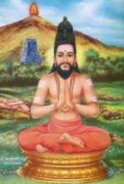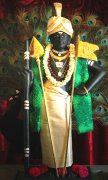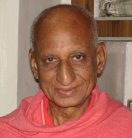

THE ESOTERIC
KANDAR ANUBHUTI
OR
THE SECRET TEACHING ON
GOD-EXPERIENCE
(A Treatise on Adwaitic Realization)
OF
SAINT ARUNAGIRINATHAR

 |  THE ESOTERIC KANDAR ANUBHUTI OR THE SECRET TEACHING ON GOD-EXPERIENCE (A Treatise on Adwaitic Realization) OF SAINT ARUNAGIRINATHAR |  |
 | by N.V. Karthikeyan |  |
| verses contents intro 1 2 3 4 5 6 7 8 9 .. 12 this verse in PDF version (4 parts) p-1 p-2 p-3 p-4 complete download of this book |
VERSE-2 உல்லாச நிராகுல யோக விதச் சல்லாப விநோதனும் நீ அலையோ எல்லாமற என்னை இழந்த நலம் சொல்லாய் முருகா சுரபூபதியே.Ullaasa niraakula yoga vithac- Challaabha vinothanum nee alaiyo Ellaamara ennai izhantha nalam, Sollaai murugaa sura bhoopathiye. Are Thou not, O Lord! Bliss, Sorrowless, and Yoga, Commentary "O Lord Muruga, You are possessed of the six attributes; pray instruct me on that 'Good' which is freedom from attachment and egoism." In this prayer, Saint Arunagiri invests the Lord with six novel attributes! What are those? God is ullasa. He is bliss. He is happiness. He is joy. He is Sat-chit-ananda. It is the Ananda or Bliss of the Consciousness or Awareness of His Omnipresence or All-pervading Existence. God is infinite existence identical with absolute consciousness. Because of this, He is ever Blissful. It is Self-bliss and not the happiness derived from something other than itself. God is niraagula -- free from sorrow. We are also happy and joyful sometimes, but our happiness is not unalloyed. Even when we are happy over something, thought of something else torments us from within. Also our happiness is short-lived, giving place to pain and bereavement. But God is not so. He is Bliss itself. He knows not what sorrow, pain or unhappiness is. Hence, to clarify this, as it were, in the second attribute He is said to be free from sorrow also. God is Yoga. And what is this happiness and freedom from sorrow due to? He is the Lord of Yoga, the Great Yogi, always in the state of Yoga or Samadhi. He also confers Yoga or union with Him to the aspiring souls. Now, what does it matter to us, if God is bliss, free from sorrow and Master of Yoga? He is not merely these. He is Ita (Hita). He is the well-wisher of all and always intends our good, for which is the prayer of this verse. God is sallaaba - possessed of kindly speech, not merely well-wishing. The Lord comes as our Guru and gives us suitable upadesa or instruction. We, in our ignorance, do not know what is good for us and often pray for those things which will bring us suffering. The Lord intends our good, speaks what is good, and also does what is good for us. God is Vinodhan -- a great Marvel-Master! He appears as this vast creation, through His sportful Lila; and provides the needed field for the Jivas to have various experiences according to their Karmas and then He releases them from His Maya by an act of grace. Who can do this marvel except Him! Thus, the Lord is bliss, freedom from sorrow, and Yoga. This is His essential nature as He is in Himself. The Lord is also good-intending, good-speaking, and good-doing. This is what He is in relation to us. He appears as this vast creation, comes as our Guru, gives us upadesa, guides us, reveals Himself to us and absorbs us into Himself. How He does all this is indeed a wonder, and we can only say that it is His Lila or Divine Sport. Thus, the blissful and sorrowless Lord of Yoga intends, speaks and does what is "Good" for us. Among the innumerable places of worship of Lord Muruga, six are foremost and are called 'Aarupadai Veedu'. These are Thirupparankundram (3 miles from Madurai); Thiruchendur (down south on the seashore); Thiruvaavinankudi or Pazhani (near Dindugal); Thiruveragam or Swamimalai (near Kumbakonam); Kundruthoradal or Thirutthani (near Arakonam) and Pazhamuthircholai (near Madurai). The six attributes of the Lord are said to denote these six places of worship. Further, these six places are also said to represent the six Chakras or plexuses in the body, which means that Shanmukha is the Lord of the six Chakras. "O Lord, are Thou not the Lord of these six attributes? (yes.) Therefore, grant me the 'Good.'" And what is that good? It is a two-fold blessedness -- that of ceasing from everything of the world and also losing the ego-sense in God. This is the "Good," to be aspired for. 'Ellaam ara' -- All things should cease, is the first state of blessedness. There are millions and millions of things in the world. Can we put an end to them all? Is it possible? No. Then, how do we cease from them? The only way is to withdraw ourselves from them. Hence, the first step in Yoga is Yama (self-restraint) constituting of 5 practices: Ahimsa (non-injury), Satya (truthfulness), Brahmacharya (all-round sense control), Asteya (non-covetousness), and Aparigraha (non-acceptance of those things that are not necessary for one's bare existence). When a total sense-control is effected, which implies also control of mind, what remains is the ego-principle or the "I." 'Ennai Izhanda' -- This should also be lost. But where? The ego is the universal asserting itself in a particular, just as the crest of the wave is the sea-water rising in a particular place. As the wave-crest sinks into the ocean, the "I" - consciousness loses itself in God-consciousness. Thus, all-ceasing and mine-losing covers the entire course of Sadhana, that of withdrawal from externality and absorption in God, which is the "Good," says Arunagirinathar. One may wrongly construe that ceasing from all external and losing oneself may mean a negative state of deep sleep, swoon, or void, wherein also these are absent. No, says the saint. That state is, therefore, emphasised as "Good." Sleep, swoon, etc., are states "not good," because they do not lead one to union with God, but revert one to the same miserable condition in which one was before going to these states. So, it is absorption in God, and not going to sleep, etc., that is indicated. The only 'Good' is God; all others which we consider as 'good' are only "goods." Therefore, losing oneself in God is Good, not losing oneself in the world, because, the world is a source of pain and misery; and God is the source of bliss, of freedom from pain and of Yoga. When one attains this Good, he becomes a saint; and saints also possess the six attributes of God mentioned in the verse. They are ever blissful, they are always free from pain and sorrow, ever absorbed in Yoga; they are intent upon the good of the world and speak to people what is good to them. They do good to them in various ways, as participants of the divine Lila. This is so because saints are representatives of God on Earth; in and through them God works here. Commencement of Sadhana or spiritual practice has been indicated in verse-1. The Sadhaka has started doing Japa and singing the glories of the Lord. But the purpose of the practice, or the Goal to be attained, was not specified therein; it is to attain God or Moksha, is pointed out in this verse. So the aspirant now prays to Murugan, the Almighty Lord, for granting him 'That Good' (Nalam) which is to let go or abandon all external attachments (ellaam ara) and melt or lose one's ego (yennai izhandha) in God. The Katha Upanishad calls this 'Nalam' as the 'Shreyas'. 'That Good' or 'Nalam' is Murugan, who is All-Bliss, etc. (ullasa, etc.). This Goal should be clear from the very beginning itself, lest the devotee should get side-tracked later by desire for name, fame, wealth, etc. Thus, 'Paadum Paniye paniyaai Arulvaaai' - "grant me the only task of singing Thy glories" -- is not for yearning a livelihood or to become a famous Sankirtanist, etc. but for attaining God. This prayer is seen fulfilled, in Toto, in verse-43. In one sense we may that the remaining verses of the Kandar Anubhuti are a detailed explanation of 'Ellam ara' (all-ceasing) and 'Yennai izhandha Nalam' (mine-losing 'Good'). In verse-1 there is no mention of any Name of the Lord such as Skanda, Muruga, Guha, etc.; He is simply referred to as 'the Brother of Lord Ganesa'. For the first time that a Name is mentioned is in this verse; it is 'Murugan'. 'Murugan' stands for the Absolute, what is termed as 'Brahman' in Vedantic texts. Hence, as we have seen earlier, Kacchiyappa Sivachariar (about the 9th century A.D.) who was ordered by Lord Shanmukha to compose the work 'Kanda Puraanam' in Tamil, by giving him the first line for his work, precisely and beautifully portrays the Lord's Avatara thus: "That Consciousness-Mass (Light or Jyoti) which is called the Supreme Brahman, which is formless, with form, beginningless, One and also the many, -- That assumed a form with six grace-showering faces and twelve hands and took Avatara or Divine Incarnation as Murugan, for the redemption of the world." Thus he equates Murugan with Brahman, i.e., 'Murugan' is the Tamil equivalent of the Sanskrit term 'Brahman'. Murugan is Brahman. Strange indeed, isn't it! In the work 'Kanda Puranam', describing the Lord's Avatara he did not use the Name Kanda or any other but only 'Murugan'. That Murugan means Brahman will be seen confirmed in verse-13. The prayer of this verse is from the Bhakta's point of view (Bhakti-Marga or the path of Devotion). In the next verse it will be from the Vedantic point of view (Jnana-Marga or the path of Wisdom). Thus we will see Bhakti and Jnana going hand in hand throughout the work of Kandar Anubhuti. |
| contents intro 1 2 3 4 5 6 7 8 9 .. 12 this verse in PDF version (4 parts) p-1 p-2 p-3 p-4 |
| ... www.kaumaram.com ... The website for Lord Murugan and His Devotees முகப்பு கௌமாரம் அட்டவணை மேலே தேடல் home Kaumaram contents top search |
If you do not see Tamil characters or for 'offline' viewing, please install 'SaiIndira' fonts from Azhagi.com download Free Azhagi software |
Kaumaram.com is a non-commercial website. This website is a dedication of Love for Lord Murugan. Please take note that Kaumaram.com DOES NOT solicit any funding, DIRECTLY or INDIRECTLY. [xhtml] .[css] |